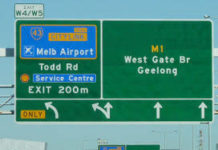(A short while ago, Grumpy Motorist and my good self (David Hiscox) borrowed a Tesla. Yes, a Tesla. Grumpy has compiled an extensive report. If I can add a few comments before I leave the rest almost entirely to Grumpy (the italics within parentheses will be my small additions). I noticed no discernable change in Grumpy’s demeanour when he drove the Tesla. On several occassions he referred to other motorists as “peasants,” a term I have heard him use not infrequently. Anyway, enjoy.)
Welcome to the XYZ’s first car review. As this is the first review of our motoring series we decided to put our judging gaze on a vehicle and company that is changing the face of global motoring, Tesla Motors.
A quick back-story on Tesla and the Model S: Tesla began with its goal to create a mass-marketable and affordable, zero emissions, fully-electric car that can compete with the internal combustion big boys; spearheaded by none other than Tony Stark… I mean Elon Musk. There really isn’t a difference between those two. The Model S is their in-house-designed, mass-marketed, production car.
(When I asked one of the Tesla staff what it is like to work for Tesla, they described it as a company which just got things done. Because they are still, essentially, a start up, they have a lot of flexibility and move very quickly on new ideas, as compared to more established organisations. In this regard, we may humbly compare ourselves here at The XYZ..)
Now, onto the car…
The Model S P90D
Dave and my grumpy self were lucky enough to be given their performance, top-of-the-line flagship model, with all added options, for a couple of days to review, and overall it was a fantastic experience in what I can safely say is the future of global motoring.
Let’s start with the negative aspects of the car, as it is a short list.
Firstly, something I found that could be potentially very dangerous for the complacent, lazy, impatient, or just unlucky, is the rear and peripheral vision with the vehicle. With such a sturdy roof frame, the pillars of the car (whom I named Ruby) are incredibly thick. While this reduces the roof crush effect, currently the safest tested in the USA, as a driver I couldn’t see obstacles or other road users from my position, even with moving around in the seat. As a rear passenger I could not see at all when exiting for anything coming – the back pillar with the boot is that thick. The large headrests on the rear seats, while comfortable, limit the stifled view even more.
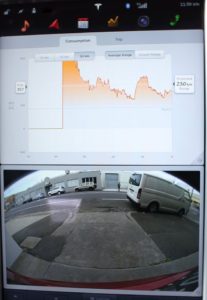
There is an extreme wide angle, almost fish eye, camera to the back that you can have on at all times, but this still doesn’t assist your vision diagonally rear of the car, and sensors can only pick up so much.
Secondly, there is no spare wheel. Not even the room to have a spare unless you want one floating around loose in your boot. So if you have a flat or a blow out you’re stuck until the Tesla roadside assistance comes and changes your tyre or tows you away. The roadside assistance is free for the life of the car. Alternatively, if you’re like me and prefer to do things yourself, you can opt for a puncture repair kit.
These were the only flaws that I discovered which concerned me safety-wise, everything else is a cosmetic/comfort grumble.
Battery location for the Model S is under the floor, the whole floor! This adds stability, strength and ultimately, greater safety to the aluminium frame. However, if you’re an adult in the back your knees will sit quite high, due to the low seats and thick floor. On the other hand, distance between the front and back is very spacious, and comfortably sits adults in the back, even the larger of human beings.
Other design issues found with the car were:
The centre console bin with charging points ended up swallowing my (AWESOME) car key under the pivoting lid curve. I eventually got this out with dexterous fingers and many swear words.
The front luggage compartment, dubbed the “frunk” by Tesla Motors staff, requires even pressure on both sides of the lid to lock it back in place, so as to not warp the bonnet. This is fine, however when operating a luggage compartment I always had something in my hands which made the task awkward for me, yet probably comical for those watching. Now, this would have been easily glossed over had the car not had an automatic closing boot. If you have auto for one why not the other? Adding to that the glove compartment and the charging point cover open automatically but not close automatically. With the amount of detail gone into this machine, a little bit extra would have been the cherry on top.
Rounding out my grumbles and gripes was the sound system. In the end, after fiddling with the equaliser on the system, its low register was still lacking. If I were to purchase one for myself I would be asking about how I can change the speakers, as my current 1998 stock Toyota sound system (with stock sub) still out performs the Model S in overall audio quality.
TO THE GOOD STUFF!

When I first pulled up at Tesla Motors I was awestruck by the cars. Their paint is immaculate, the lines are so sleek and flowing and sadly the photos on their promotional material and the ones we have taken just don’t do these vehicles justice. They are, before even getting in, a gorgeous car. I would have to say red, with the red brake callipers and the black 21″ wheels, would be my favourite. It was elegant and sporty, something that catches the eye (and that it did when we were driving as well.)
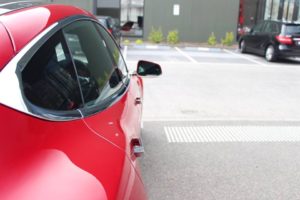
Cars are not only something practical, they are a work of art. Whether it is restoring something or creating a new design, like any art form, if it is rushed without care, it’s going show in the end result. Take a look at the Ssangyong cars, the Toyota Rukus, the Nissan Juke or Cube; these cars, while practical (not sure about the Juke) are eyesores. As such, the bond between man and machine is less because you will always covet the better-looking ride.
There is something very important with the look of a car as well as its practicality. Tesla have done that inside and out with the Model S. Not only have they made a good-looking car, they have incorporated some impressive quirks into that design as well. Walk up to the car with the key in your pocket (the key is a mini Model S, the size of a matchbox car!) and the handles extend from the doors and the mirrors unfold, and that’s the car unlocked! With the chrome handles on the fantastic red finish, I felt like I was Tony Stark!
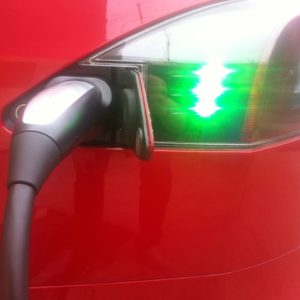
When recharging the car you point the plug at the area where it plugs in and the cap is released, opening up the port for access. “Look, mum! No hands!” is what I wanted to say each time I went to do something with this car.
This car is fast! Fast doesn’t even describe how quick it is. I went into this review without anyone else’s prior experience in one to alter my expectations of the vehicle. I knew that electric motors are able to put power to the wheels faster than an internal combustion engine. There isn’t the need for cylinders to fire faster and faster, you just alter the power and instantly an electric motor changes its speed; that’s just 8th grade electronics.
When Dave and I got into the car and drove for a bit, we had no idea of the power under the… well, between the wheels. We had a couple of tests planned for speed, so we went to a safe area and got the stop watch out:
0-60, about a second
60 – 100 was 1.7 seconds
0-110 was 3.7 seconds
(All of these times are marred with human error). The rate of acceleration meant that by the time I registered we had hit the speed it was already 10km over by the time I told Dave to stop the clock. Officially from Tesla Motors they state that 0 – 100km/ph is 3.3 seconds in a standard Model S P90D, and 3 seconds when engaging “ludicrous mode,” which of course we did!
(I love the fact that Tesla have referenced Spaceballs. Also, the G-forces gave me a head-ache. Some upper-body training, akin to that undertaken by Formula 1 drivers, may be necessary.)
The acceleration is phenomenal! Unlike an internal combustion engine, there is no lag as the engine kicks in. Your foot goes down and you welcome the Gs.
The handling is so responsive. I threw the car around corners and it would not falter, it was there every step of the way with what I was asking of it. Even on grass it held true. This can be attributed to the almost 50/50 front to rear weight distribution and 4 wheel drive.
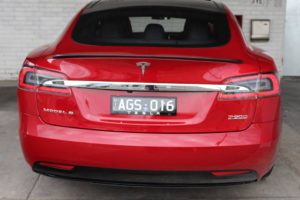
I was also lucky in the fact that of the two days I had the vehicle, I had one day dry and one day wet to really see how the handling held up. After a bad crash in the wet in the past, I’m always very wary of driving when wet. Once the rain drops there’s a sense of unease I get as a driver and as a passenger in many cars. I didn’t feel at all unsafe while driving in the wet (both damp and extreme wet.) The car didn’t slide or slip, even on paint.
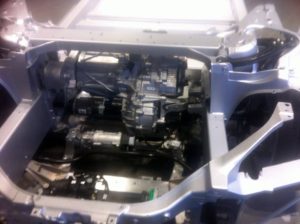
The Model S is so quiet, there’s no engine noise at low speeds, only a whine as you push the engine a bit and even then it’s super quiet. The road noise and wind is louder. It’s a strange sensation. I have a powerful car and I want everyone around me to know, but they never will. I foresee a few pedestrian with phone related accidents as they step onto the road without looking because there is no sound.
(An upside to this is that as an overworked XYZ editor who frequently doesn’t sleep, if you need to take a nap in the passenger seat, it is nothing short of glorious.)
A few other minor changes to my driving habits had to be altered to compensate for how the Model S operates. The biggest one was the use of the accelerator pedal. When in a combustion engine car you reach your speed, then you release the pedal briefly to encourage a gear change and then sit on your speed with the pedal down again, in the Model S, just put your foot in position and leave it. Likewise in a combustion engine car, when slowing down to a stop, you release the pedal and coast, using friction to slow down. In the Tesla, you do that and regenerative braking starts to occur and the vehicle brakes, putting charge back into the batteries. So releasing the pedal had to be done later to compensate for a quicker deceleration.
I use the term “car” very loosely with this review. It’s less a car and more a smartphone/tablet… a mobile device that can also throw your insides into the back seat. Everything from the Model S is controlled by the centre touch screen computer. A big 17″ control surface.
It runs like a smartphone or tablet. It is very quick to get used to, and like any new phone, there will be a teething period where you get to grips with small changes with the system but from then on you will have no problem with it. Only having the car for two days, I got a good grasp on the central control system, however, I knew there was still so much I was missing out on.
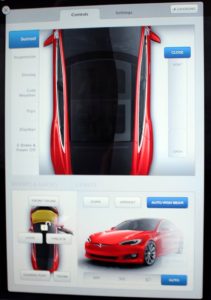 The screen, and therefore the car, has its own 3G data connection (at no cost) that allows the computer to be updated with live traffic congestion Google maps, run Spotify (also at no cost) and most importantly, be able to be accessed by Tesla Motors for software servicing (for example, for an owner in a remote area).
The screen, and therefore the car, has its own 3G data connection (at no cost) that allows the computer to be updated with live traffic congestion Google maps, run Spotify (also at no cost) and most importantly, be able to be accessed by Tesla Motors for software servicing (for example, for an owner in a remote area).
You can set up different driver profiles, and changing each profile will change the settings of the car to the preferred operating conditions of the driver, including seats, mirrors, steering wheel etc.
The screen can be split in two showing two of the main operating options, for example the rearward camera and maps, or have one of the apps taking up the full screen. The choices are:
Radio/media: Giving you not only digital radio but access to Spotify streaming and Bluetooth to a device.
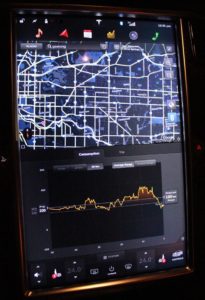 Calendar: synced to your phone, all your appointments are accessible here.
Calendar: synced to your phone, all your appointments are accessible here.
Google Maps: with navigation.
Statistics: Energy expenditure and projected range plus trip details
Rearward camera: because seeing backwards with your eyes is actually worse without it. This also has car direction indicators that come on when reversing.
Phone: from here you can dial a number, access your contacts, and previous call lists of your mobile.
Going further down the technological rabbit hole you can enter the control panel. From there you can alter the car. Change the handling, raise or lower suspension, adjust the sunroof, toggle on or off driving modes like creep or ludicrous, alter crash avoidance systems, access the vehicle manual, and oh so very much more.
Autopilot
No, not cruise control, AUTOPILOT! This is one of the great selling points of the Model S. This feature uses road lines to centre itself in the lane with auto steering and cruise control. As you come up on a slower car the Model S slows to keep pace at a set distance (I had Ruby set to three car-lengths) and centred in the lane. Once you have grown weary of the slow-poke Holden in front of you driving at 15km/ph under the speed limit in the centre lane the Model S can, at the flick of your indicator (YES, YOU HAVE TO USE AN INDICATOR!!!), change lanes and return to your original speed. (Although when you try this, make sure the lane change feature is turned on, unlike me who sat in a lane for a few minutes trying to change lanes with nothing happening and wondering why.)
A feature I like about the autopilot and lane changing is that you have to keep your hands on the wheel. The car knows when you don’t. This is good as it keeps the driver somewhat attentive as to what is happening on the road around them. In my first experience with autopilot I had my hands on my lap talking with Dave, the car kept yelling at me to put my hands on the wheel but I kept refusing. It reached a point where the car finally cracked it at my lack of compliance, cut the systems and started to stop, making me take control of the car again.
(It must be said, watching Grumpy Motorist argue with one of the most high-tech computer systems ever devised and put into a car was among the highlights of my day. Oh and also, he tested out the autopilot by eating a chocolate bar.)
When the car is in control of the speed (cruise control, autopilot) it will automatically break if there are cars ahead of it. This feature kept me in a good mood while driving in heavy traffic, as instead of constantly turning my cruise off and on, I didn’t notice the speed change until someone was overtaking me. This feature is able to be turned off and also it’s able to be adjusted for sensitivity. I found Medium to be too sensitive as it would slow right down, almost to a stop for a car turning 20m ahead.
Auto parking is also available however I didn’t succeed in getting this feature to work while I had the machine. I did however get one of the Tesla staff to show me. It will, automatically, from a command from the centre computer, park itself either at 90 degrees or parallel.
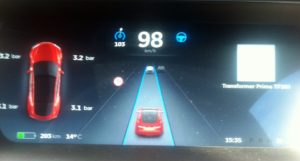 There is still a dashboard in the Model S, unlike the release photos of the Model 3, and its focus is on the car and what’s around it. Centre is a little Model S and will have surrounding alerts come up as obstacles/cars get close, indication where the lines are and vehicles in front. This works well with the autopilot/lane change feature, as you can see the limitations and why actions are happening. The speedo is top centre, and going from an advisory speed check, is 2km/ph slower than it states.
There is still a dashboard in the Model S, unlike the release photos of the Model 3, and its focus is on the car and what’s around it. Centre is a little Model S and will have surrounding alerts come up as obstacles/cars get close, indication where the lines are and vehicles in front. This works well with the autopilot/lane change feature, as you can see the limitations and why actions are happening. The speedo is top centre, and going from an advisory speed check, is 2km/ph slower than it states.
To the left and right of the dash are changeable pieces of info. It was the left side that interested me more as when your surrounding sensors started to detect something, it would zoom in on the location (again, another car diagram) with a flowing alert ring. Unlike the other sensor displays I have seen, this digital diagram bent around what was there. So if you were coming up on a pole, it had a curve in the sensor band marking it out, and as it got closer a distance would show until you get so close that it yelled at you to stop. It is the most accurate and useful I have seen to date.
Comfort
I didn’t at all feel like I needed to get out and stretch; the leather interior looks like a European design and is nice to the touch. Climate control is able to be controlled in regions and individual seats, even the three in the back, can be heated at different temperatures. If you have never experienced a heated leather steering wheel, please treat yourself, it’s wonderful. The climate control also contains a bio-defence option, which is interesting to have. I’m not exactly sold on its necessity, however, the HEPA air filtration system that it comes with is interesting to me, filtering out the fumes from that belching diesel monstrosity in front of you that is trying to accelerate from the lights.
Unlike a petrol engine, as you run more and more extras in the car it doesn’t take away power from the motor. It of course lowers the range that the car will have; however if you want to go from 0 to 100 km/ph, you will still do that in 3 seconds.
So we don’t have petrol, and electric cars take so long to recharge: how will this car be any different to the Nissan Leaf?
Firstly, you will get far more admiring looks from people around you in the Model S than the vomit-worthy Leaf.
Secondly, when you purchase a Tesla, the company will install a charger at your home for easy home charging. This system of charge will give you approx. 10km per hour of charging and runs at about 7.4kw/ph. Now that’s still pretty slow, but better than other full electric cars on the market at the moment.
 But wait! There’s more! Upon owning a Tesla you will have access to the Tesla supercharge network (so far it’s only available in two locations in Melbourne and at town locations between Sydney and Melbourne) which will give the car battery a full charge in about an hour… for free! So if you live near, or get a super charging station built near your home or work, you could essentially never need to pay for road transport in your car again (outside of that dreaded registration fee of course) as you laugh at all us peasants paying through the nose for petrol.
But wait! There’s more! Upon owning a Tesla you will have access to the Tesla supercharge network (so far it’s only available in two locations in Melbourne and at town locations between Sydney and Melbourne) which will give the car battery a full charge in about an hour… for free! So if you live near, or get a super charging station built near your home or work, you could essentially never need to pay for road transport in your car again (outside of that dreaded registration fee of course) as you laugh at all us peasants paying through the nose for petrol.
A full charge will give you about 500km range. There’s a funky little app on the Tesla Model S webpage that will give you projections on ranges in different conditions with each different type of Model S. With my harder driving and use of as many features as I could, I reduced the charge on Ruby quite a lot. However, after the two days, I didn’t need to recharge to get the car back to Tesla, even with long highway driving included.
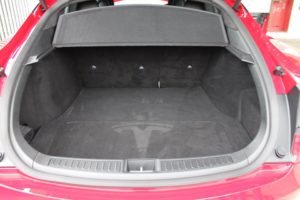 Storage in the Model S is quite generous. The trunk has a secondary lower compartment, can have its top canopy removed for bulkier items, and of course you can lower the back seats to fit the surfboard in with no issues of getting wax all over your nice upholstery.
Storage in the Model S is quite generous. The trunk has a secondary lower compartment, can have its top canopy removed for bulkier items, and of course you can lower the back seats to fit the surfboard in with no issues of getting wax all over your nice upholstery.
The space in the “frunk” is limited, as much of the space there is taken up by what a unsuspecting person would think was the motor, but it’s more components for air con, brake fluid, computer witchcraft, etc. This was perfect for small items like bags, jacket, etc. Also I enjoyed the gimmick of putting items in the front of the car.
Running costs
Will an owner of a Model S save money, verses buying a comparable combustion machine?
Short answer is yes, and while the initial outlay for a Model S will be dear, in terms of ongoing costs you will save plenty.
Firstly, as stated earlier, you won’t be at the whim of the oil companies paying about $50 a week on fuel. It will be part of your home electricity bill, and if you have solar panels then that’s even cheaper for you.
Secondly, with so few moving parts in the Model S there are less things to go wrong; instead of needing a service every 3 months/five to ten thousand kilometres for basics like fluids and filters, and needing big, costly services for belts and water pumps every 100,000 kilometres, the Model S is serviced once a year and much of it is software based. The servicing is all prepaid up to the first 8 years (see the Tesla site for the different options) and due to frequency, works out much cheaper.
So how much will this sting?
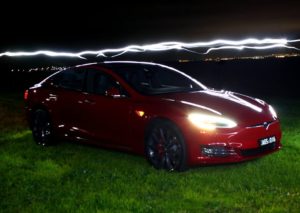
If you go to buy Ruby, the top of the line Model S P90D with all the bells and whistles plus the kitchen sink, it will set you back about $282,000. That includes $11,000 stamp duty, $45,000 luxury car tax and $37 Victorian rego costs.
There are, of course, lesser variants of the Model S which will drop the price, and maybe you don’t need the $15,000 ludicrous speed upgrade or the $6,000 21″ rims. The thing with Tesla is you can go onto their site, pick the type of Model S you want, add all the options, tell them which state you’re in and then you will be given the price for it with all on-roads. With Tesla, the price is set no matter who you are – you pay the same as the individual before and the individual after.
Personally, I like that. While I have haggled down prices before, it’s annoying to talk to someone who got the exact same product for cheaper from the same dealer. Also it doesn’t cheapen the product. Once you start taking $2,000 off the marked price the moment you walk in the door the respect for the product is lost.
When I first saw the price sheet sent to me from Tesla Motors I was incredibly sceptical that this car was worth the price of a small house. Especially if they’re trying to mass-market them. After driving it for the two days, I can confidently say that it is worth every dollar (except the luxury car tax!)
If, like me, spending almost $300,000 on a car is a bit out of your price range, then next year there will be a release of a more affordable Tesla: the Model 3. With no released Australian price yet, I can only speculate that it will range between $40,000 and $60,000.
This experience with the Model S has won me over to electric cars, well… good ones that is. I acknowledge that there is a place still for combustion engines; I don’t want to go camping with an electric car that’s for sure. But for daily commuting vehicles this really is something so much more!
If you have any questions about this car that we haven’t covered, ask Dave or Grumpy in the comments below.
(Standby for the up-coming review of the SpaceX Falcon 9 in a couple of years’ time).




